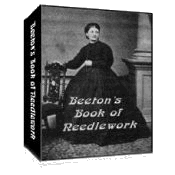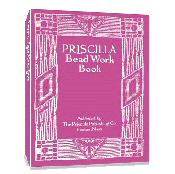[]Subscribe To This Site
Directions for Cut Work
Edited excerpt from Doyley and Centre-Piece Book, 1896

Click on Cut Work Corner Piece picture above to see more detail.
The first consideration for Cut Work is, of course, the material to be used, which should be firm and not ravel easily; this being procured, and the pattern having been stamped upon it, the next thing is to stretch the work in a frame, or small hoops, which are more convenient than the frame, in that they are more easily held when working; or another expedient is to baste the material to a stiff paper, if neither frame nor hoops are to be had. Then, first, the filling stitches are put in; and these will be more readily understood from our cut. The stems it will be seen are worked in cat-stitching exactly as the seams of a flannel skirt are stitched flat; some of the spaces are filled with lattice work, some with French knots and others with detached sprigs of briar stitching. Any other stitches that fancy dictates may be equally well used. By trying these separate stitches on a small scrap of material, one will easily learn the most convenient as well as the most economical manner of executing them.
After all the spaces of the part of the work in the frame have been filled with these stitches, the buttonholing of the outline is begun. This is accomplished either with or without the aid of a cord or small, flat braid. When the braid or cord is used, it is laid along the outline, and caught into place by buttonhole stitches at small intervals, perhaps one-sixteenth of an inch apart. When the cord or braid is not used, the buttonhole stitches are set quite close together. The bars which connect the different parts of the pattern and serve to hold it together after the intervening material is cut away are worked at the same time as the buttonholing-that is, a short portion of the buttonholing is worked until the place for a bar is reached, and then, without cutting the thread, it is passed across where the bar is to be, caught at the other side and twisted back to the place of beginning; the buttonholing is then continued until another bar is necessary. In this way the awkwardness of passing the thread from one bar to another is wholly avoided and the work is neater.

Click on Cut Work Buttonholing Stitch picture above to see more detail.
Some ladies, instead of twisting the thread back for these bars, work back to the place of starting with buttonhole stitches on the single thread. This method makes a rather heavier bar, and is to be preferred in very open patterns.
Where small rings are introduced, they are worked separately beforehand, and held in position while the connecting bars are worked. The manner of making these rings is as follows: The thread is first wrapped once or twice around something of suitable size — a lead pencil is a good size for large rings, and a small crochet needle will answer for smaller ones — and after being slipped off the pencil carefully, the ring is either buttonholed or crocheted over all around, thus making it quite substantial. Small rings may also be worked at the intersection of the bars. After the work is entirely completed, the portions to be cut away are removed by means of sharp scissors, the cutting being done on the wrong side, and, of course, great care must be taken not to cut any of the bars or other work.

Click on Cut Work Ring picture above to see more detail.
These directions are minute, for the purpose of assisting any who may not have perfectly understood the manner of working from former articles on the same subject. And if the process is not perfectly clear on reading the directions, it would probably become so if a small piece of work is begun and the directions followed; each step will then be clear as one comes to it.

Click on Cut Work picture above to see more detail.
The pattern would be very handsome worked on silk sheeting. Thus worked it would form an elegant center for a plush sofa cushion, and for this purpose the center of the square should be cut out, and in order to do this the braid on the inside of the square should be buttonholed both ways. When used as an appliqué for a sofa cushion it could form a frame for initials or other embroidery. Worked on cream linen it would form a striking decoration for dark blue Bolton sheeting, denim or plush.
Return to top of Cut Work page.
Return to Types of Embroidery page.
Return to Home page.



 433 pages!
433 pages!

